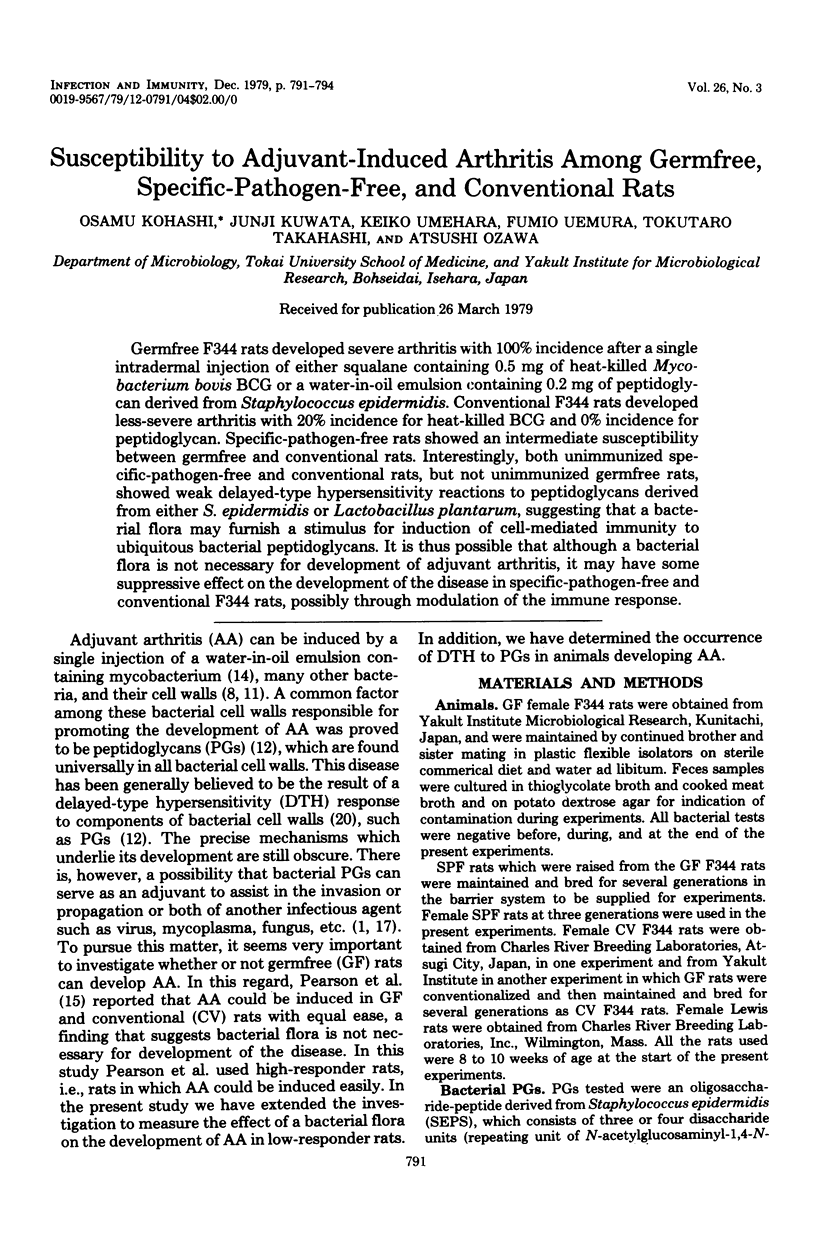Susceptibility to adjuvant-induced arthritis among germfree, specific-pathogen-free, and conventional rats (original) (raw)
Abstract
Germfree F344 rats developed severe arthritis with 100% incidence after a single intradermal inection of either squalane containing 0.5 mg of heat-killed Mycobacterium bovis BCG or a water-in-oil emulsion containing 0.2 mg of peptidoglycan derived from Staphylococcus epidermidis. Conventional F344 rats developed less-severe arthritis with 20% incidence for heat-killed BCG and 0% incidence for peptidoglycan. Specific-pathogen-free rats showed an intermediate susceptibility between germfree and conventional rats. Interestingly, both unimmunized specific-pathogen-free and conventional rats. but not unimmunized germfree rats, showed weak delayed-type hypersensitivity reactions to peptidoglycans derived from either S. epidermidis or Lactobacillus plantarum, suggesting that a bacterial flora may furnish a stimulus for induction of cell-mediated immunity to ubiquitous bacterial peptidoglycans. It is thus possible that although a bacterial flora is not necessary for development of adjuvant arthritis, it may have some suppressive effect on the development of the disease in specific-pathogen-free and conventional F344 rats, possibly through modulation of the immune response.

Selected References
These references are in PubMed. This may not be the complete list of references from this article.
- Bacon P. A., Bluestone R., Goldberg L. S., Webb F. W., Pearson C. M., Cooke M., Stevens J. G. Experimental herpes virus arthritis. Factors in chronicity. Ann Rheum Dis. 1974 Sep;33(5):413–421. doi: 10.1136/ard.33.5.413. [DOI] [PMC free article] [PubMed] [Google Scholar]
- Bolton R. W., Chorpenning F. W. Naturally occurring cellular and humoral immunity to teichoic acid in rats. Immunology. 1974 Oct;27(4):517–524. [PMC free article] [PubMed] [Google Scholar]
- Frederick G. T., Holmes R. A., Chorpenning F. W. Naturally occurring cell-mediated immunity to purified glycerol-teichoic acid antigen in guinea pigs. J Immunol. 1972 Dec;109(6):1399–1401. [PubMed] [Google Scholar]
- Haley T. J., Farmer J., Jaques W. E., Frith C., Sprowls R. W., Schieferstein G. Dose-response hyperplasia and neoplasia from feeding N-2-fluorenylacetamide (2-FAA) to BALB/c mice for varying time intervals. Proc Soc Exp Biol Med. 1976 Jun;152(2):156–159. doi: 10.3181/00379727-152-39350. [DOI] [PubMed] [Google Scholar]
- Jungi T. W., McGregor D. D. Impaired chemotactic responsiveness of macrophages from gnotobiotic rats. Infect Immun. 1978 Feb;19(2):553–561. doi: 10.1128/iai.19.2.553-561.1978. [DOI] [PMC free article] [PubMed] [Google Scholar]
- Katayama T., Matsuda T., Kato K., Kotani S. Isolation and purification of D-alanyl-meso-2, 6-diaminopimelic acid endopeptidase of Streptomyces L-3 enzyme using soluble substrates of known chemical structure from Lactobacillus plantarum cell wall digests. Biken J. 1976 Sep;19(3):75–91. [PubMed] [Google Scholar]
- Kayashima K., Koga T., Onoue K. Role of T lymphocytes in adjuvant arthritis. I. Evidence for the regulatory function of thymus-derived cells in the induction of the disease. J Immunol. 1976 Nov;117(5 PT2):1878–1882. [PubMed] [Google Scholar]
- Koga T., Maeda K., Onoue K., Kato K., Kotani S. Chemical structure required for immunoadjuvant and arthritogenic activities of cell wall peptidoglycans. Mol Immunol. 1979 Mar;16(3):153–162. doi: 10.1016/0161-5890(79)90140-8. [DOI] [PubMed] [Google Scholar]
- Koga T., Pearson C. M., Narita T., Kotani S. Polyarthritis induced in the rat with cell walls from several bacteria and two Streptomyces species. Proc Soc Exp Biol Med. 1973 Jul;143(3):824–827. doi: 10.3181/00379727-143-37421. [DOI] [PubMed] [Google Scholar]
- Kohashi O., Pearson C. M. Arthritogenicity of Mycobacterium smegmatis subfractions, related to different oil vehicle and different composition. Int Arch Allergy Appl Immunol. 1976;51(4):462–470. doi: 10.1159/000231620. [DOI] [PubMed] [Google Scholar]
- Kohashi O., Pearson C. M., Watanabe Y., Kotani S., Koga T. Structural requirements for arthritogenicity of peptidoglycans from Staphylococcus aureus and Lactobacillus plant arum and analogous synthetic compounds. J Immunol. 1976 Jun;116(6):1635–1639. [PubMed] [Google Scholar]
- Kohashi O., Pearson M., Beck F. J., Alexander M. Effect of oil composition on both adjuvant-induced arthritis and delayed hypersensitivity to purified protein derivative and peptidoglycans in various rat strains. Infect Immun. 1977 Aug;17(2):244–249. doi: 10.1128/iai.17.2.244-249.1977. [DOI] [PMC free article] [PubMed] [Google Scholar]
- Matsuda T., Kotani S., Kato K. Structure of the cell walls of Lactobacillus plantarum, ATCC 8014. 1. Isolation and identication of the peptides released from cell wall peptidoglycans by Streptomyces L-3 enzyme. Biken J. 1968 Jun;11(2):111–126. [PubMed] [Google Scholar]
- PEARSON C. M. Development of arthritis, periarthritis and periostitis in rats given adjuvants. Proc Soc Exp Biol Med. 1956 Jan;91(1):95–101. doi: 10.3181/00379727-91-22179. [DOI] [PubMed] [Google Scholar]
- PEARSON C. M., WOOD F. D., McDANIEL E. G., DAFT F. S. Adjuvant arthritis induced in germ-free rats. Proc Soc Exp Biol Med. 1963 Jan;112:91–93. doi: 10.3181/00379727-112-27959. [DOI] [PubMed] [Google Scholar]
- Schleifer K. H., Kandler O. Peptidoglycan types of bacterial cell walls and their taxonomic implications. Bacteriol Rev. 1972 Dec;36(4):407–477. doi: 10.1128/br.36.4.407-477.1972. [DOI] [PMC free article] [PubMed] [Google Scholar]
- Thomas L. Experimental mycoplasma infections as models of rheumatoid arthritis. Fed Proc. 1973 Feb;32(2):143–146. [PubMed] [Google Scholar]
- Ueda K., Yamazaki S., Someya S. Hyporeactivity to tuberculin in germ-free mice. J Reticuloendothel Soc. 1975 Aug;18(2):107–117. [PubMed] [Google Scholar]
- Ueda K., Yamazaki S., Someya S. Studies on tubercle bacillus infection in germ-free mice. J Reticuloendothel Soc. 1972 Nov;12(5):545–563. [PubMed] [Google Scholar]
- WAKSMAN B. H., PEARSON C. M., SHARP J. T. Studies of arthritis and other lesions induced in rats by injection of mycobacterial adjuvant. II. Evidence that the disease is a disseminated immunologic response to exogenous antigen. J Immunol. 1960 Oct;85:403–417. [PubMed] [Google Scholar]
- Wood F. D., Pearson C. M., Tanaka A. Capacity of mycobacterial wax D and its subfractions to induce adjuvant arthritis in rats. Int Arch Allergy Appl Immunol. 1969;35(5):456–467. doi: 10.1159/000230198. [DOI] [PubMed] [Google Scholar]